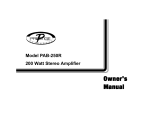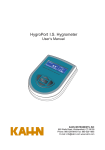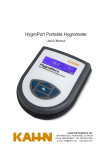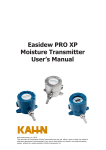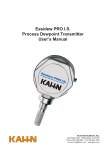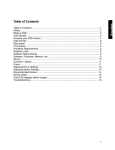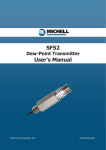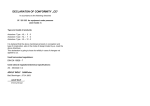Download Easidew Dewpoint Transmitter User`s Manual
Transcript
tte r 09 06 Easidew Dewpoint Transmitter User’s Manual 0 i sm 2 an + Tr 0 / ew 10 sid Ea ge: n Ra Kahn Instruments, Inc. 2015 This document is the property of Kahn Instruments and may not, either in part or whole, be copied or otherwise reproduced, communicated in any way to third parties nor stored in any data processing system, without the written authority of Kahn Instruments, Inc. Easidew Transmitter User’s Manual Contents Safety.................................................................................................................................iii Electrical Safety............................................................................................................iii Pressure Safety.............................................................................................................iii Toxic Materials..............................................................................................................iii Repair and Maintenance................................................................................................iii Calibration....................................................................................................................iii Safety Conformity.........................................................................................................iii Abbreviations.......................................................................................................................iv Warnings.............................................................................................................................iv 1INTRODUCTION.................................................................................................1 1.1Features............................................................................................................. 1 2INSTALLATION...................................................................................................2 2.1 2.2 2.3 2.4 2.4.1 2.5 2.5.1 2.5.2 Unpacking the Instrument.................................................................................... 2 Preparation of the Sensor Cable........................................................................... 3 Cable Connection................................................................................................ 4 Electrical Schematic............................................................................................. 4 Electrical Boundaries...................................................................................... 5 Transmitter Mounting........................................................................................... 5 Transmitter Mounting - Sample Block (Optional)............................................... 6 Transmitter Mounting - Direct Pipeline Connection............................................ 7 3OPERATION.......................................................................................................8 4MAINTENANCE...................................................................................................9 Figures Figure Figure Figure Figure Figure Figure Figure Figure Figure Figure Figure Figure 1 2 3 4 5 6 7 8 9 10 11 12 Transmitter Unpacking Method.....................................................................2 Connector Terminal Block Removal...............................................................3 Wiring Connections......................................................................................3 Connector Installation..................................................................................4 2-Wire Connection Diagram..........................................................................4 Maximum Load of Easidew - Including Cable Resistance.................................5 Transmitter Mounting - Sensor Block.............................................................6 Transmitter Mounting - Pipe or Duct.............................................................7 Installation Location....................................................................................8 Indication of Dead Space.............................................................................8 Replacement of HDPE Guard........................................................................9 Dimensions - Easidew ...............................................................................12 Appendices Appendix A Appendix B Appendix C Technical Specifications .............................................................................. 11 UL Certification........................................................................................... 13 EC Declaration of Conformity....................................................................... 14 2 Issue 9.1 December 2012 Easidew Transmitter User’s Manual Safety The manufacturer has designed this equipment to be safe when operated using the procedures detailed in this manual. The user must not use this equipment for any other purpose than that stated. Do not apply values greater than the maximum value stated. This manual contains operating and safety instructions, which must be followed to ensure the safe operation and to maintain the equipment in a safe condition. The safety instructions are either warnings or cautions issued to protect the user and the equipment from injury or damage. Use competent personnel using good engineering practice for all procedures in this manual. Electrical Safety The instrument is designed to be completely safe when used with options and accessories supplied by the manufacturer for use with the instrument. Pressure Safety DO NOT permit pressures greater than the safe working pressure to be applied to the instrument. The specified safe working pressure is 5000 psig. Refer to the Technical Specifications in Appendix A. Kahn Instruments 3 Easidew Transmitter User’s Manual Abbreviations The following abbreviations are used in this manual: barg ºC ºF DC ft-lbs g in µm m/sec mA max mm MPa Nl/min Nm oz ppmV psig RH scfh scfs T V Ω ø pressure unit (=100 kP or 0.987 atm) gauge degrees Celsius degrees Fahrenheit direct current foot-pound force grams inch(es) micrometer meters per second milliampere maximum millimetres megapascal normal liters per minute Newton meter ounces parts per million by volume pounds per square inch relative humidity standard cubic feet per hour standard cubic feet per second temperature Volts Ohms diameter Warnings The following general warning listed below is applicable to this instrument. It is repeated in the text in the appropriate locations. Where this hazard warning symbol appears in the following sections it is used to indicate areas where potentially hazardous operations need to be carried out. 4 Issue 9.1 December 2012 Easidew Transmitter User’s Manual 1 INTRODUCTION INTRODUCTION The Easidew dew-point transmitter has been manufactured, tested and calibrated to the highest available standards and should be in good working order, ready for installation into a gas measurement application. If there are any questions about the instrument or how to install and operate it, please contact a Kahn representative (for Kahn Instruments’ contact information go to www.kahn.com). 1.1 Features The Easidew dew-point transmitter is a continuous on line 4-20mA transmitter for the measurement of moisture content in air and other non-corrosive gases. The key features are: • 4-20 mA 2-wire loop powered connection • Dew-point OR parts per million (moisture content) in volume (ppmV) measurements • Accuracy (±3.6ºFdp (±2ºCdp)) • Repeatability (0.9ºFdp (0.5ºCdp)) • Dew-point values traceable to international standards (NIST) • Excellent sensor protection (rugged 316 stainless steel NEMA 4 construction) • Interchangeability Kahn Instruments 1 Easidew Transmitter User’s Manual INSTALLATION 2 INSTALLATION 2.1 Unpacking the Instrument On delivery, please check that all the following standard components are in the packing box: • Easidew Transmitter • Bonded Seal • Certificate of Calibration • Connector (for sensor/cable) Unpack the dew-point transmitter box as follows: 1 2 3 4 5 Figure 1 6 7 8 Transmitter Unpacking Method 1. Remove the cap (1) from the packing tube (8). 2. Remove the foam block (3) containing the connector (2). 3. Pull out the transmitter (5) from the tube, complete with the two foam covers (6) and (7) and the red protective cap (4). 4. Remove the foam covers from the transmitter but leave the blue plastic protective cover (5) and the red cap (4) in place until ready for installation. NOTE: The transmitter sensing element is protected while in transit by a blue cover containing a small desiccant capsule. The connection pins are protected by a red plastic cap. These plastic items must be removed for the operation of the transmitter. NOTE: Keep the connector (2) in a safe place until the transmitter is ready for wiring. 2 Issue 9.1 December 2012 Easidew Transmitter User’s Manual 2.2 INSTALLATION Preparation of the Sensor Cable The sensor cable is NOT supplied as standard. A cable can be obtained by contacting Kahn Instruments (see www.kahn.com for details). Cable connection to the Easidew transmitter is made via the removable connector. Removing the central screw enables the connector terminal block to be removed from the outer housing by using a small screwdriver to pry it clear. O-ring and washer Connector Terminal Block Removal Figure 2 Caution: When removing the central screw, insure that the small sealing O-ring and the washer are retained on the screw and are present during re-installation. For the transmitter to work properly, and to achieve maximum performance, the sensor cable must be connected to the sensor connector as shown in the drawing below: Note: The drawing below shows the identity of the connector terminals and wiring connections of the cable manufactured by Kahn Instruments: GN GREEN - 4-20 mA RED + POWER BLUE - SCREEN RD BL 3 BLUE GND 2 4 BRAID SCREEN GREEN YELLOW BLUE RED RED +POWER 1 BRAID GREEN SIGNAL (SOURCE) SHORT AS POSSIBLE GREEN - 4-20 mA (SOURCE) BLUE - SCREEN RED + POWER VIEW ON REAR OF CONNECTOR SCALE 2:1 Figure 3 Wiring Connections Always connect the 4-20 mA return signal to a suitable load (see Figure 3) before the power is applied. Without this connection, the transmitter may be damaged if allowed to operate for prolonged periods. Kahn Instruments 3 Easidew Transmitter User’s Manual INSTALLATION 2.3 Cable Connection When installing the connector, and to insure that full ingress protection is achieved, the retaining screw (with the O-ring and washer) must be tightened to a minimum torque setting of 2.5 ft-lbs (3.4 Nm). The sensor cable used must be a minimum diameter of 0.2” (4.6mm). Figure 4 2.4 Connector Installation Electrical Schematic NOTE: The screen/shield should be connected for maximum performance and to avoid interference. 3 1 + Screen/ Shield Figure 5 Max Load 250R @ 12V 500R @ 24V Supply 12V Min 28V Max 2-Wire Connection Diagram 4 Issue 9.1 December 2012 Easidew Transmitter User’s Manual 2.4.1 INSTALLATION Electrical Boundaries Resistance (ohms) 600 500 400 300 200 100 12 14 16 18 20 22 24 26 28 Supply Voltage Figure 6 2.5 Maximum Load of Easidew - Including Cable Resistance Transmitter Mounting Prior to installation of the transmitter, unscrew and remove the blue plastic cover and retain for future use. Take care to prevent any contamination of the sensor before installation (handle the transmitter by the main body only, avoiding contact with the sensor guard). The Easidew can be mounted into either a flow-through sensor sampling block (optional) or directly inserted into a pipe or duct and can be operated at pressures of up to 5000 psig when installed with the bonded seal provided. The recommended gas flow rate, when mounted in the optional sampling block, is 2 to 10 scfh (1 to 5 Nl/min). However, for direct insertion applications, gas flow can be from static to 33 fps (10 m/sec). NOTE: Place the bonded seal over the 5/8”- 18 UNF mounting thread and assemble into the sampling location by hand using the wrench flats only. DO NOT grip and twist the sensor cover when installing the sensor. When installed, fully tighten using a wrench until the seal is fully compressed and to the following torque setting: 5/8” - 18 UNF 22.5 ft-lbs (30.5 Nm) Kahn Instruments 5 Easidew Transmitter User’s Manual INSTALLATION 2.5.1 Transmitter Mounting - Sample Block (Optional) The following procedure must be carried out by a qualified installation technician. To mount the transmitter into the sensor block (preferred method), proceed as follows, refer to Figure 7. 1. Insure that the protective cover (2), and its desiccant capsule (2a), have been removed from the tip of the transmitter. 2. Install the bonded seal (4) over the threaded part of the transmitter body. WARNING: Under no circumstances should the sensor guard be handled with the fingers. 3. Screw the transmitter (1) into the sample block (3) and tighten to a minimum torque setting of 22.5 ft-lbs (30.5 Nm). NOTE: Use the flats of the hexagonal nut and not the sensor body. 4. Attach the transmitter cable/connector assembly (6) to the plug located on the base of the transmitter and tighten the retaining screw (7) (see Section 2.3). Figure 7 Transmitter Mounting - Sensor Block 6 Issue 9.1 December 2012 Easidew Transmitter User’s Manual 2.5.2 INSTALLATION Transmitter Mounting - Direct Pipeline Connection The transmitter may be directly mounted into a pipe or duct, as shown in Figure 8 CAUTION: Do not mount the transmitter too close to the bottom of a bend where any condensate in the pipeline might collect and saturate the probe. The pipe or duct will require a thread to match the transmitter body thread. Installation dimensions are shown in Figure 8. For circular pipework, to insure the integrity of a gas tight seal, a mounting flange will be required on the pipe in order to provide a flat surface to seal against. The following procedure must be carried out by competent personnel. 1. Insure that the blue protective cover (and its desiccant capsule) has been removed from the tip of the transmitter. WARNING: Under no circumstances should the sensor guard be handled with the fingers. 2. Install a bonded seal (2) over the threaded part of the transmitter body. 3. Screw the transmitter (3) into the pipe (1). Tighten enough to obtain a gas tight seal. (Torque will depend upon the pipeline material.) NOTE: Do not overtighten or the thread on the pipe may be stripped. Figure 8 Transmitter Mounting - Pipe or Duct Kahn Instruments 7 Easidew Transmitter User’s Manual OPERATION 3 OPERATION Operation is very simple assuming the following installation techniques are adhered to: Sampling Hints Be Sure the Sample is Representative of the Gas Under Test: The sample point should be as close to the critical measurement point as possible. Also, never sample from the bottom of a pipe as entrained liquids may be drawn into the sensing element. Figure 9 Installation Location Minimize Dead Space in Sample Lines: Dead space causes moisture entrapment points, increased system response times and measurement errors, as a result of the trapped moisture being released into the passing sample gas and causing an increase in partial vapor pressure. Deadspace Figure 10 Indication of Dead Space Remove Any Particulate Matter or Oil from the Gas Sample: Particulate matter at high velocity can damage the sensing element and similarly, at low velocity, they may 'blind' the sensing element and reduce its response speed. If particulate, such as degraded desiccant, pipe scale or rust is present in the sample gas, use an in-line filter, as a minimum level of protection. For more demanding applications Kahn Instruments offers a range of sampling systems (for more information contact www.kahn.com). Use High Quality Sample Tube and Fittings: Kahn Instruments recommends that, wherever possible, stainless steel tubing and fittings should be used. This is particularly important at low dew points since other materials have hygroscopic characteristics and adsorb moisture on the tube walls, slowing down response and, in extreme circumstances, giving false readings. For temporary applications, or where stainless steel tubing is not practical, use high quality thick walled PTFE tubing. Position Transmitter away from Heat Source: It is recommended, as good instrumentation practice, that the transmitter be placed away from any heat source to avoid adsorption/desorption. 8 Issue 9.1 December 2012 Easidew Transmitter User’s Manual 4 MAINTENANCE MAINTENANCE Calibration Routine maintenance of the Easidew is confined to regular re-calibration by exposure of the Easidew to sample gases of known moisture content to ensure that the stated accuracy of the Easidew is maintained. Calibration services traceable to the National Institute of Standards and Technology (NIST) are provided by Kahn Instruments. Kahn Instruments offers a variety of re-calibration and exchange sensor programs to suit specific needs. A Kahn representative can provide detailed, custom advice (for Kahn Instruments contact information go to www.kahn.com). Sensor Guard Replacement The sensor is supplied with a white HDPE guard (standard) or a stainless steel guard (if specified at time or order). The method of replacement is the same for both types. HDPE Guard The HDPE guard provides <10μm protection to the dew-point sensor. It is designed to show any contamination and the guard should be changed if the surface becomes discolored. When replacing the guard, care should be taken to handle the guard by the bottom part only. Replacement guards (EA2-HDPE) - pack of 10 - can be obtained by contacting Kahn Instruments (www.kahn.com). HANDLE, USING GLOVES, BY BLACK PART ONLY ru H menE m it te r 09 06 C I MInst ew 34 g an e: n s 0 a 0 -1 +2 Tr 0 / te rW m ay B b ri dg es CB 6 3N d Ki ng s id as Replacement of HDPE Guard R 48 La nc E ly , C a it e Figure 11 Ea U n Stainless Steel Guard The stainless steel guard provides <80μm protection to the dew-point sensor. It is designed to show any contamination and the guard should be changed if the surface becomes discolored. When replacing the guard, care should be taken to handle the guard by the bottom part only. A replacement guard (SSG) can be obtained by contacting Kahn Instruments (www.kahn.com). Bonded Seal If the installed bonded seal gets damaged or lost, a pack of 5 replacement bonded seals can be obtained by contacting Kahn Instruments, and quoting part number BS-58-PK5. Kahn Instruments 9 APPENDIX A Easidew Transmitter User’s Manual Appendix A Technical Specifications 10 Issue 9.1 December 2012 Easidew Transmitter User’s Manual Appendix A APPENDIX A Technical Specifications Performance Measurement Range (Dew Point) -148 to +68ºFdp (-100 to +20ºCdp) Accuracy (Dew Point) ±3.6ºFdp (±2ºCdp) Response Time 5 mins to T95 (dry to wet) Repeatability 0.9ºFdp (0.5ºCdp) Calibration 13 point calibration with traceable 7 point calibration certificate Electrical Specification Output Signal Output Analog Output Scaled Range Supply Voltage Load Resistance Current Consumption CE Marked 4-20 mA (2-wire connection current source) User-configurable over range Dew point or moisture content for ppmV Dew point: -148 to +68ºF (-100 to +20ºC) OR Moisture content in gas: 0 - 3000 ppmV Non-standard available upon request 12 to 28 V DC Max 250 Ω @ 12 V (500 Ω @ 24 V) 20 mA max Certified Operating Specifications Operating Temperature Operating Pressure Flow Rate Temperature Coefficient -40 to +140ºF (-40 to +60ºC) 5000 psig max 2 to 10 scfh (1 to 5 Nl/min) mounted in standard sampling block; 0 to 33 fps (0 to 10 m/sec) direct insertion Temperature compensated across operating temperature range Mechanical Specifications Ingress Protection Housing Material Dimensions Sensor Guard Process Connection & Material Weight Interchangeability Electrical Connection Diagnostic Conditions (factory programmed) Digital Diagnostic Communications NEMA 4 in protection accordance with standard NEMA 250-2003 IP66 in accordance with standard BS EN60529:1992 316 stainless steel Transmitter plus connector 5.19” x ø1.77” (L=132mm x ø45mm) Standard: HDPE Guard < 10µm Optional: 316 stainless steel sintered guard < 80µm 5/8” - 18 UNF 316 stainless steel 5.29oz (150g) Fully interchangeable transmitter Hirschmann GDS series (DIN 4350-C) Condition Output Sensor fault 23 mA Under-range dew point 4 mA Over-range dew point 20 mA RS485, 2-wire Modbus RTU Kahn Instruments 11 Easidew Transmitter User’s Manual APPENDIX A Dimensions Sensor 5/8” Bonded Seal 10mmø27mm (0.39”) (1.06”) 27mm (1.06”) A/F 46mm (1.81”) ø25.4 x 2mm (ø1 x 0.07”) 45mm (1.77”) 132mm (5.19”) 5/8” 18 UNF 10mm (0.39”) Figure 12 Dimensions - Easidew 12 Issue 9.1 December 2012 Easidew Transmitter User’s Manual APPENDIX B Appendix B UL Certification Listing Number E331965 Standards: UL61010-1 2nd Edition CAN/CSA C22.2 No. UL61010-1 2nd Edition Kahn Instruments 13 APPENDIX C Easidew Transmitter User’s Manual Appendix C EC Declaraton of Conformity 14 Issue 9.1 December 2012 Easidew Transmitter User’s Manual Appendix C APPENDIX C EC Declaration of Conformity Kahn Instruments 15 http://www.kahn.com




















